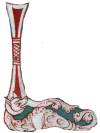Here begins the excerpts from the decretals of the Holy Fathers
A learned layman had a concubine. At last he left her and immediately became a subdeacon. Next he took a wife. After a short time he became a deacon and was then elected bishop.
It is asked whether those who marry and after assuming clerical office should be separated?
Second should a cleric who had a concubine be ordained a bishop?
Third should someone who has just been received in sacred orders be ordained a bishop?
Q. i. <c.1> Augustine says in his book On a Good Marriage that those who marry after a vow should not be separated
Some say that those who marry after a vow are adulterers. However, I say that whoever separates them sins gravely.
<c.2>. Again Theodorus:
If a man who has sworn a vow of virginity takes a wife, he should not leave his wife but do penance for three years.
<c.3> "It is abominable," he says, "not only that those who vow chastity marry but even wish to marry."
<c.4> Again in Contra Jouinianum:
If a virgin marries she does not sin --- not a virgin who had dedicated herself once to divine worship. If she marries, she will be damned because she broke faith.
<c.5> Again Nicolaus
A woman took the veil after the death of her husband, feigned to be a nun, and afterwards married. Because she wanted to disturb ecclesiastical discipline through hypocrisy and not legitimately preserve her vow, let her do penance for her heinous fiction and let her return to her commitment.
<c.6>. Again Calixtus Papa
We absolutely forbid priests, deacons, or subdeacons to live with concubines and wives and to cohabit with other women. We decree that according to the sacred canons that marriages contracted with these sorts of persons should be annulled, and they should do penance.
We may distinguish between those making simple vows to which Augustine and Theodorus spoke and solemn vows. Solemn vows are those made and then followed by the consecration of benediction.
St Gall, Stiftsbibliothek 673, fol. 3
